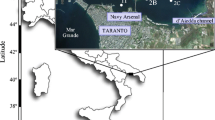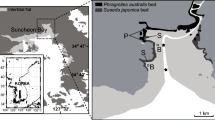Abstract
The food sources of benthic deposit feeders were investigated at three stations in an estuarine mudflat (Idoura Lagoon, Sendai Bay, Japan) during July and August 2005, using δ13C and δ15N ratios. Sediment at the stations was characterized by low chlorophyll (chl) a content (0–1 cm depth, <4 μg cm−2) and the dominance of riverine–terrestrial materials (RTM) in the sediment organic matter (SOM) pool. Surface-deposit feeders (Macoma contabulata, Macrophthalmus japonicus, and Cyathura muromiensis) exhibited much higher δ13C values (−18.4 to −12.4‰) than did the SOM pool (<−25‰). A δ13C-based isotopic mixing model estimated that benthic diatoms comprised 45–100% (on average) of their assimilated diet, whereas RTM comprised a lesser fraction (29% maximum). The major diet of the deep-deposit feeding polychaetes Notomastus sp. and Heteromastus sp. was benthic diatoms and/or marine particulate organic matter (POM), with little RTM assimilated (39% maximum). The consumers appeared to lack specific digestive enzymes and to use detritus-derived carbon only after its transfer to the microbial biomass. The isotopic mixing model also showed that the dietary contribution of RTM increased slightly (15% maximum) in the vicinity of freshwater input, suggesting that spatial changes in RTM supply affect the dietary composition of deposit feeders. These results clearly demonstrate that deposit feeders selectively ingest and/or assimilate the more nutritious microalgal fractions in the SOM pool. Such adaptations may allow enhanced energy gain in estuarine mudflats that are rich in vascular plant detritus with low nutritive value.


Similar content being viewed by others
References
Cahoon LB (1999) The role of benthic microalgae in neritic ecosystems. Oceanogr Mar Biol Ann Rev 37:47–86
Carman KR, Fry B (2002) Small-sample methods for δ13C and δ15N analysis of the diets of marsh meiofaunal species using natural abundance and tracer-addition isotope techniques. Mar Ecol Prog Ser 240:85–92. doi:10.3354/meps240085
Chanton J, Lewis FG (2002) Examination of coupling between primary and secondary production in a river-dominated estuary: Apalachicola Bay, Florida, U.S.A. Limnol Oceanogr 47:683–697
Doi H, Matsumasa M, Toya T, Satoh N, Mizota C, Maki Y et al (2005) Spatial shifts in food sources for macrozoobenthos in an estuarine ecosystem: carbon and nitrogen stable isotope analyses. Estuar Coast Shelf Sci 64:316–322. doi:10.1016/j.ecss.2005.02.028
Fauchald K, Jumars PA (1979) The diet of worms: a study of polychaete feeding guilds. Oceanogr Mar Biol Ann Rev 17:193–284
Galván K, Fleeger JW, Fry B (2008) Stable isotope addition reveals dietary importance of phytoplankton and microphytobenthos to saltmarsh infauna. Mar Ecol Prog Ser 359:37–49. doi:10.3354/meps07321
Hylleberg J, Gallucci VF (1975) Selectivity in feeding by the deposit-feeding bivalve Macoma nasuta. Mar Biol (Berl) 32:167–178. doi:10.1007/BF00388509
Ito K (2002) Carbon and nitrogen stable isotope ratios of planktonic and benthic diatoms. Jpn J Limnol 63:166–168 In Japanese
Kanaya G, Kikuchi E (2004) Relationships between sediment chemical buffering capacity and H2S accumulation: comparative study in two temperate estuarine brackish lagoons. Hydrobiologia 528:187–199. doi:10.1007/s10750-004-2342-8
Kanaya G, Kikuchi E (2008) Spatial changes in a macrozoobenthic community along environmental gradients in a shallow brackish lagoon facing Sendai Bay, Japan. Estuar Coast Shelf Sci 78:674–684. doi:10.1016/j.ecss.2008.02.005
Kanaya G, Nobata E, Toya T, Kikuchi E (2005) Effects of different feeding habits of three bivalve species on sediment characteristics and benthic diatom abundance. Mar Ecol Prog Ser 299:67–78. doi:10.3354/meps299067
Kanaya G, Takagi S, Nobata E, Kikuchi E (2007) Spatial dietary shift of macrozoobenthos in a brackish lagoon revealed by carbon and nitrogen stable isotope ratios. Mar Ecol Prog Ser 345:117–127. doi:10.3354/meps07025
Kanaya G, Takagi S, Kikuchi E (2008) Spatial dietary variations in Laternula marilina (Bivalva) and Hediste spp. (Polychaeta) along environmental gradients in two brackish lagoons. Mar Ecol Prog Ser 359:133–144. doi:10.3354/meps07356
Kang C-K, Kim JB, Lee K-S, Kim JB, Lee P-Y, Hong J-S (2003) Trophic importance of benthic microalgae to macrozoobenthos in coastal bay systems in Korea: dual stable C and N isotope analyses. Mar Ecol Prog Ser 259:79–92. doi:10.3354/meps259079
Kikuchi E, Wada E (1996) Carbon and nitrogen isotope ratios of deposit-feeding polychaetes in the Nanakita River Estuary, Japan. Hydrobiologia 321:69–75. doi:10.1007/BF00018678
Kristensen JH (1972) Carbohydrases of some marine invertebrates with notes on their food and on the natural occurrence of the carbohydrates studied. Mar Biol (Berl) 14:130–142. doi:10.1007/BF00373212
Lamb AL, Wilson GP, Leng MJ (2006) A review of coastal palaeoclimate and relative sea-level reconstructions using δ13C and C/N ratios in organic material. Earth Sci Rev 75:29–57. doi:10.1016/j.earscirev.2005.10.003
Levin LA, Blair N, DeMaster D, Plaia G, Fornes W, Martin C et al (1997) Rapid subduction of organic matter by maldanid polychaetes on the North Carolina slope. J Mar Res 55:595–611. doi:10.1357/0022240973224337
Lopez GR, Levinton JS (1987) Ecology of deposit-feeding animals in marine sediments. Q Rev Biol 62:235–260. doi:10.1086/415511
McCutchan JH Jr, Lewis WM Jr, Kendall C, McGrath CC (2003) Variation in trophic shift for stable isotope ratios of carbon, nitrogen, and sulfur. Oikos 1022:378–390. doi:10.1034/j.1600-0706.2003.12098.x
MacIntyre HL, Geider RJ, Miller DC (1996) Microphytobenthos: the ecological role of the “secret garden” of unvegetated, shallow-water marine habitats. I. Distribution, abundance and primary production. Estuaries 19:186–201. doi:10.2307/1352224
Macko SA, Engel ME, Parker PL (1993) Early diagenesis of organic matter in sediments: assessment of mechanisms and preservation by the use of isotopic molecular approaches. In: Engel MA, Macko SA (eds) Organic geochemistry. Plenum Press, New York, pp 211–224
Middelburg JJ, Barranguet C, Boschker HTS, Herman PMJ, Moens T, Heip CHR (2000) The fate of intertidal microphytobenthos carbon: an in situ 13C-labeling study. Limnol Oceanogr 45:1224–1234
Miyagi Prefecture (1990) III Suishitsu chosa. In: Miyagi Prefecture (ed) Idoura Chiku (Kanhai) I-71 gou “Idoura Gawa kankyo cyosa gyomu houkokusho”. Miyagi Prefecture, Sendai, Japan, pp 70–120 (in Japanese)
Ono Y (1967) On the ecological distribution of ocypoid crabs in the estuary. Mem Fac Sci Kyushu Univ Ser E Biol 4:1–60
Phillips DL, Gregg JW (2003) Source partitioning using stable isotopes: coping with too many sources. Oecologia 136:261–269. doi:10.1007/s00442-003-1218-3
Rhoads DC (1974) Organism–sediment relations on the muddy sea floor. Oceanogr Mar Biol Ann Rev 12:263–300
Riera P, Richard P (1996) Isotopic determination of food sources of Crassostrea gigas along a trophic gradient in the estuarine bay of Marennes-Oleron. Estuar Coast Shelf Sci 42:347–360. doi:10.1006/ecss.1996.0023
Sullivan MJ, Moncreiff CA (1990) Edaphic algae are an important component of salt marsh food-webs: evidence from multiple stable isotope analyses. Mar Ecol Prog Ser 62:149–159. doi:10.3354/meps062149
Tsuchiya M, Kurihara Y (1979) The feeding habits and food sources of the deposit-feeding polychaeta, Neanthes japonica (Izuka). J Exp Mar Biol Ecol 36:79–89. doi:10.1016/0022-0981(79)90101-1
Tsutsumi H, Wainright S, Montani S, Saga M, Ichihara S, Kogure K (2001) Exploitation of a chemosynthetic food resource by the polychaete Capitella sp. I. Mar Ecol Prog Ser 216:119–127. doi:10.3354/meps216119
Vanderklift MA, Ponsard S (2003) Sources of variation in consumer-diet δ15N enrichment: a meta-analysis. Oecologia 136:169–182. doi:10.1007/s00442-003-1270-z
van Oevelen D, Moodley L, Soetaert K, Middelburg JJ (2006) The trophic significance of bacterial carbon in a marine intertidal sediment: results of an in situ stable isotope labeling study. Limnol Oceanogr 51:2349–2359
Wada E, Minagawa M, Mizutani H, Tsuji T, Imaizumi R, Karasawa K (1987) Biogeochemical studies on the transport of organic matter along the Otsuchi River watershed, Japan. Estuar Coast Shelf Sci 25:321–336. doi:10.1016/0272-7714(87)90075-8
Yokoyama H, Ishihi Y (2007) Variation in food sources of the macrobenthos along a land-sea transect: a stable isotope study. Mar Ecol Prog Ser 346:127–141. doi:10.3354/meps07010
Yoshii K, Melnik NG, Timoshkin OA, Bondarenko NA, Anoshko PN, Yoshioka T et al (1999) Stable isotope analyses of the pelagic food web in Lake Baikal. Limnol Oceanogr 44:502–511
Acknowledgments
We thank Dr. K. Ito for access to the mass spectrometer at the Department of Agriculture, Tohoku University, as well as A. Muraoka for her help with analyzing the sediment samples. We also thank the editor and three anonymous referees for their critical comments on this manuscript. This study was partly supported by Grant-in-Aid for Scientific Research (C) from Japan Society for the Promotion of Science (No. 17570012).
Author information
Authors and Affiliations
Corresponding author
Additional information
Communicated by J. P. Grassle.
Rights and permissions
About this article
Cite this article
Kanaya, G., Takagi, S. & Kikuchi, E. Dietary contribution of the microphytobenthos to infaunal deposit feeders in an estuarine mudflat in Japan. Mar Biol 155, 543–553 (2008). https://doi.org/10.1007/s00227-008-1053-5
Received:
Accepted:
Published:
Issue Date:
DOI: https://doi.org/10.1007/s00227-008-1053-5




